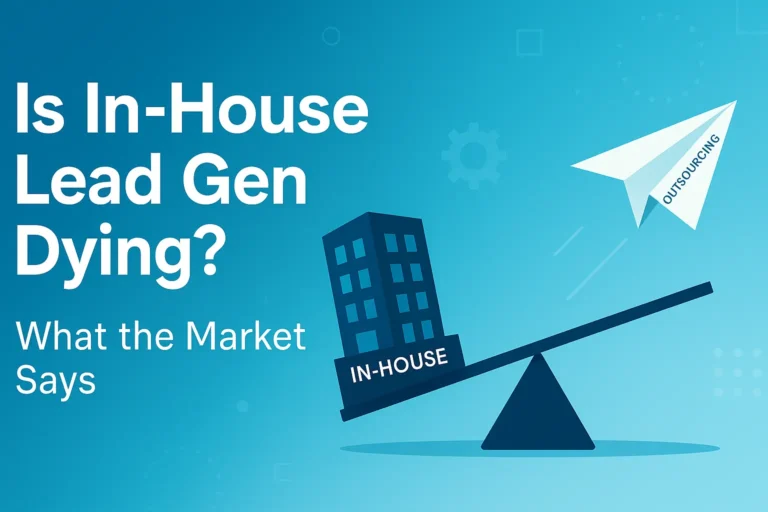How AI is Changing B2B Lead Generation (And What to Do About It)
AI isn’t a futuristic add-on anymore—it’s reshaping how B2B companies find and nurture new buyers every single day. Gartner expects that by 2025 fully 80 % of all supplier-buyer interactions will happen in digital channels, and AI is the engine behind much of that shift.
What’s driving the change?
Until recently, lead generation was largely a manual grind: buy a list, send a batch email, hand everything to sales. Today, data lakes, large language models, and real-time intent signals let revenue teams spot buying committees long before they fill out a form. In McKinsey’s 2024 State of AI survey, more than half of C-level executives said they already use generative AI at work, with sales and marketing showing the fastest uptake. At the same time, McKinsey estimates generative AI could unlock an additional $0.8–1.2 trillion in annual productivity across global sales and marketing functions.
Four concrete ways AI is rewriting B2B lead generation
1. Richer prospect profiles in seconds.
Tools such as Clay, Apollo, and ZoomInfo’s AI enrichment layer automatically scrape firmographics, technographics, hiring signals, and social intent for millions of accounts. Your ideal-customer profile is no longer a back-of-the-napkin sketch; it’s a living database updated daily. A recent Forbes round-up counted 19 AI add-ons that plug directly into common CRMs to make this enrichment happen with a single click.
2. Hyper-personal outreach—without the copy-paste fatigue.
Language models trained on your brand voice can write first-touch emails, LinkedIn notes, and even call scripts that reference a prospect’s latest funding news in real time. FullFunnel’s 2025 review of AI sales tools shows average reply-rate lifts of 30–40 % once teams switch from templated mails to AI-generated micro-personalization.
3. Predictive timing and intent scoring.
Instead of handing sales a static MQL list, AI ranks prospects by how likely they are to buy this quarter. It reads web visits, product-usage patterns, and even word choice in help-desk tickets to flag “ready now” accounts. Gartner calls this emerging practice “augmented RevOps,” where models continually refine the scoring logic themselves.
4. Always-on data hygiene.
Duplicate records and stale emails kill campaigns. Generative agents now sit inside the CRM, de-duping contacts, correcting job titles, and filling missing fields every night—work that used to eat hundreds of operations hours.
What to do about it—five practical steps
- Audit your data foundation. AI can’t fix bad data. Run a one-time cleanse of your CRM and marketing-automation platform. Remove dead domains, normalize industry tags, and verify email deliverability. If resources are tight, start with the 20 % of accounts that drive 80 % of pipeline.
- Pick a single, high-leverage use case, then expand. Generative email copy is often the easiest entry point because it shows immediate lift and needs minimal integration. Once your team is comfortable, add predictive intent scoring or automated list building.
- Keep humans in the loop. AI suggests; reps decide. Require a quick scan before any AI-drafted email goes out. Encourage sellers to add a personal anecdote—a recent conference, a mutual connection—that models can’t know.
- Measure what matters. Don’t just count raw leads. Track qualified meetings per rep-hour and pipeline velocity. These metrics reveal whether AI is actually freeing up selling time.
- Invest in upskilling. Leading firms run internal AI boot camps or on-demand tutorials. According to Gartner, organizations that pair tool rollouts with structured training see triple the seller adoption rate
Avoid common pitfalls
- Bias and hallucination. Large models can invent facts. Tie every enrichment field back to a verifiable source link, and limit free-text personalization to safe topics (e.g., public company news).
- Regulatory landmines. EU and US privacy rules increasingly treat intent data as personal data. Document how your AI providers source, store, and secure signals.
- Voice drift. Over-automated copy starts to sound robotic. Train models on your best high-response emails and refresh that training data quarterly.
The bottom line
AI won’t replace the art of building trust with another human—but it will replace many of the tedious tasks that keep teams from getting to that first conversation. The companies winning in 2025 treat AI as a co-pilot: gathering cleaner data, surfacing warmer accounts, and drafting smarter messages so that reps can focus on the part that still matters most—listening.
The sooner you move from spreadsheets to self-learning systems, the sooner your calendar fills with qualified buyers instead of “just browsing” leads.
AI is changing the rules—let it change your results, too.







